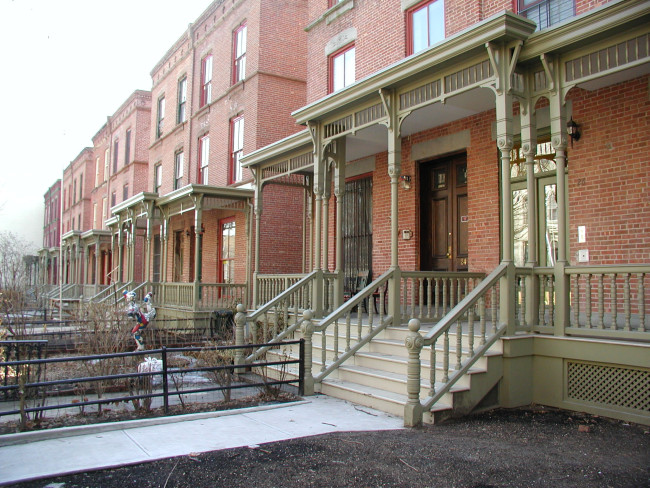A row of 12 houses near Audubon Park has a fascinating history—but do they have a future?

Audubon Terrace
Photos: Wayne Benjamin
Like surprises? If so, take the number 1 train to Washington Heights, get off at 157th Street, walk one block north, turn left, and walk toward the river. On the south side of the street, standing in a neat little row, are 12 homes, all built at the very end of the 19th century. All were developed, designed, and built by one man, and all stand as silent sentinels to the changes that the 20th century has brought to the surrounding neighborhood.
Vivian Ducat, co-chair of the Riverside Oval Association, a neighborhood group that is fighting to preserve these 12 homes, says these ”wonderful" properties "have front yards, unlike a lot of other rowhouses in New York” and are “architecturally very different from more common and predictable brownstones.” In fact, the Historic Districts Council honored them recently by placing the row on its 2016 "Six to Celebrate" list, saying that they were "representing an earlier phase of development and an alternative vision of how the area should be developed as transit moved northward at the turn of the 20th century."
The homes—numbers 626-648—are on the edge of Audubon Park, the area from 155th Street to 158th Street (west of Broadway) named for its most famous resident, the naturalist and author John James Audubon. Audubon bought the generous parcel of land in 1841 and built a house at what is now 155th and Riverside Drive for himself, his wife, Lucy, and two sons, per a Landmarks Preservation Commission report. According to the book New York Old and New by Rufus Rockefeller Wilson, the land “consisted of forty-four acres, all heavily wooded, at that time almost as remote from the city as a lodge in the Catskills.”
Right after the Hudson River Railroad made northern Manhattan accessible, the area went from farmland to commuter-friendly suburb allowing the financially strapped Audubons to divide their land, sell lots and build houses for sale or lease. No more orchards, fields, animals and forests; Italianate Victorian villas on hilly plots built for a dozen families and their servants rose, instead.
Subsequent developments in mass transit changed the face of the district dramatically and are the reason that the 12 homes on West 158th Street are aptly called “a tiny Alamo” by Christopher Gray in the New York Times (because, like the Alamo, it's a last hold out, a remnant) and considered by some to be worthy of official landmark status.
Read on for more about this uptown enclave:
1. Two savvy men see the future and decide to build for it.
The 12 houses (much like the ones on Astor Row in Harlem) were built on spec and designed by one man, John Leo, who built the first eight houses from 1896 to 1897; a year later, his business partner, John Lilliendahl, built the last four. Leo and Lilliendahl were betting on the fact that a subway would soon come to the area and with it, a population boom. They won the bet.
In the spring of 1900, the first “real” excavation of the subway began on the corner of Broadway and 156th Street. There had been what had been considered a somewhat more “official” groundbreaking in front of City Hall in March, but it was mostly ceremonial. The New York Sun reported that the festivities in northern Manhattan made the “recent tablet-laying in front of City Hall seem like a country cattle show on a rainy day.” The hero of the day was Corporation Counsel John Whalen who had fought hard for the uptown tunnel —and just happened to own a house on West 155th Street.
The row of 12 are the oldest houses in the immediate neighborhood and they are, considering the 100-plus years that they have stood in the same spot, highly intact. The one on the most westerly end of the row, is being worked on now and features one of the most endangered architectural features of all — two oriel windows that project out from the wall of the building.
Local resident and historian Matthew Spady who has spent years researching the Audubon Park area, lauds the unusual steps that the original row-house owners took to “‘increase the value of their respective premises and to improve the character of the neighborhood’. Lacking any zoning ordinances, they agreed on a series of covenants and restrictions that specified exactly what they could—and could not build. These houses remain as a testament to their version of city planning.”
2. One of the earliest rowhouse owners was one of the city’s first preservationists--but, he lost the fight to save the Audubon house.
Reginald Pelham Bolton bought the house at no. 638 West 158th Street in 1897 and lived there until 1942. Born in England and trained as an engineer (he contributed to the heating, lighting and water system designs of the city’s first skyscrapers), Bolton was passionate about the history and archaeology of Manhattan. An early proponent of historic preservation, he served as Vice President of New York’s first preservation lobby.
Bolton led the successful effort to preserve Poe Cottage in the Bronx but was less successful in his attempt to save the Audubon home from the wrecking ball. He fought for thirty years to preserve the structure but eventually lost the fight. The house fell victim to decay, vandalism and lack of funds, and was torn down in 1931 by an apartment developer. According to the Times, it “ was moved piecemeal to a nearby city lot and the whereabouts of the fragments of the great naturalist's last home are unknown.”
How ironic that the preservation effort that is now being mounted by Audubon Park neighbors is focused primarily on Bolton’s old home. The key to the neighborhood’s future may very well depend on whether landmark status is granted to his former home and the rest of the row. If it is not, a high rise might replace some or all of what is there now. (See below for more on the landmarking effort.)
3. “They paved paradise and put up a parking lot,” just like Joni Mitchell said.
When the rowhouses were originally built they had front gardens and in the back, stretching the length of the row, there was a garden shared by all the homeowners. A photo of Bolton taken in the 1930s shows him standing in the garden, leaning against a cement bird bath with a lush garden behind him complete with trellises, trees, flowers and a footpath.Now, that same garden space has been paved over and is a parking lot with parking fees collected by the owners of one of the row houses.
Josette and Gordon Bailey, who moved to the block in the 1960s and still own the home there, remember the garden. Although it was in a state of disrepair by the time they moved in, Gordon remembers playing back there where it was overgrown but he could still see remnants of cement tables and chairs and a once upon a time fish pond that was covered with weeds. “It was a child’s delight, a perfect place to play with my GI Joes and firetrucks," he tells Brick Undeground.
When the Baileys moved in, the road in front of their house was cobblestone. Josette says that she was “heartbroken when they paved it over—loved to hear the sound of the cars on the cobblestones in the rain.”
4. Neighbors have coalesced around an effort to landmark the row houses; now it’s a “wait and see.”
Ducat, besides being the co-chair of the Riverside Oval Association, is a broker with Halstead, so when she noticed that the houses on the block were changing hands, she decided that the time had come for them to be landmarked (the row is not part of the landmarked Audubon Park Historic District).
The Audubon Park Historic District, designated in 2009, includes all or part of five blocks from West 155th Street to West 158th Street, from Broadway and Edward M. Morgan Place to Riverside Drive West. It does not include the 158th Street row of homes, even though they are older than the apartment buildings that are included.
She and Spady sat down and in the period of two weeks, wrote an application to the “Six to Celebrate” competition sponsored by the Historic District Council. Soon after, the Council designated the row houses as one of the six and since then, the HDC has been “holding our hands” and helping us through the complexities of the community process of landmarking, she says.
In a letter to the Landmarks Preservation Commission, Ducat and Spady explained the urgency of their request: “ We believe if we do not act quickly, at least one of the houses could be demolished and a vacant lot stretching behind it and seven others in the row could be developed with a structure that is architecturally inconsistent with those houses and buildings already landmarked as the Audubon Park Historic District.”
5. What's for sale nearby.
While there's nothing currently for sale or rent within the 12 houses, you can buy a 2300-square-foot apartment, made up of two units combined—with four or five bedrooms, three baths and a patio—in the River Arts building, which is in the Audubon Park district and faces West 158th Street, for an asking price of $1.575 million (pictured below).

Alternatively (and for a lot less money and space), a two-bedroom condo at 812 Riverside Drive is asking $650,000.
You Might Also Like


























